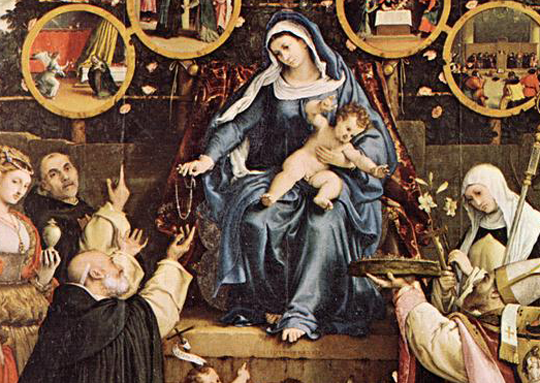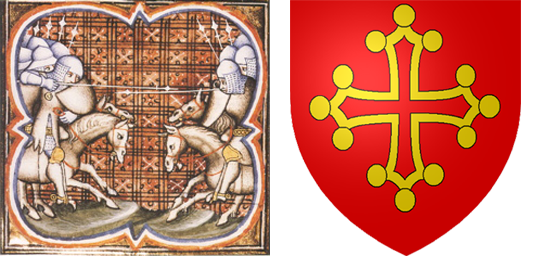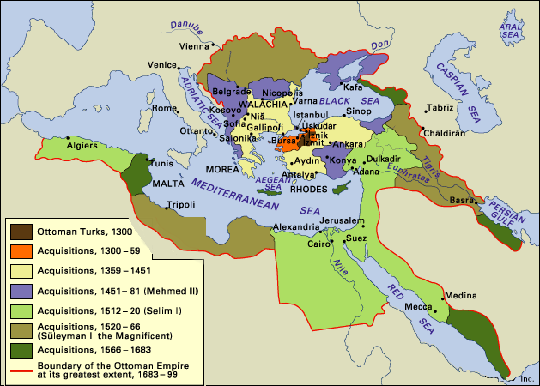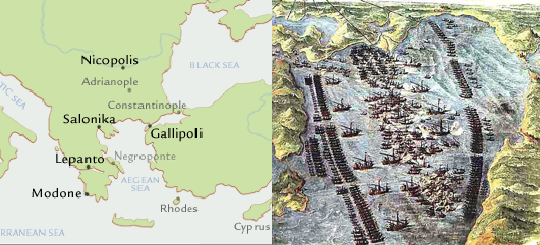LEGEND holds that St. Dominic received the Rosary from the Virgin Mary in a vision, in AD 1208. The Church does not require Catholics to believe this story. Some do. Others do not. I happen to be one of those who believe.

This detail from the 1539 oil painting “Madonna of the Rosary” by Lorenzo Lotto, portrays the legendary event in which the Virgin Mary gave the Rosary to St. Dominic in A.D. 1208. Lotto’s painting resides today in the Church of San Nicolo in Cingoli, Italy. To see the entire painting, go here. |
St. Dominic and the Rosary
As the 13th century dawned, a sect of heretics known as Cathars or Albigensians had taken over Languedoc — a large province of southern France — as well as many neighboring regions. These are the same Cathars whom novelist Dan Brown glorified in his bestselling potboiler The Da Vinci Code, as well as the hit film it inspired, starring Tom Hanks.
Nearly 800 years ago, an obscure Spanish priest traveled into the heart of Cathar country, to preach the true faith to the heretics. He would one day become known as Santo Domingo — St. Dominic — the founder of the Dominican Order.

Above left: Crusaders and Cathars clash at the Battle of Muret, September 12, 1213. Above right: The Cross of Toulouse, borne by Cathar warlord Raymond VI, Count of Toulouse, came to be known as the Cathar Cross — symbol of the heretical forces St. Dominic battled by means of the Holy Rosary, entrusted to him by the Virgin Mary.
St. Dominic set up his headquarters in the town of Fanjeaux in 1206, becoming its parish priest and taking charge of its ancient church, Notre Dame de Prouille. In Fanjeaux, St. Dominic founded a convent for young women fleeing the vice and debauchery of the Cathar sect. Soon after, St. Dominic added monks to his growing community. From these small beginnings, he planted the seeds of what would later become the Dominican Order.
Church tradition tells us that, in the year 1208, St. Dominic had a vision of the Virgin Mary while praying in his church. The Blessed Mother reportedly taught him to pray the Rosary, telling him to use this weapon to defeat the heretics.
Aflame with enthusiasm, St. Dominic called on Catholics and heretics alike to pray the Rosary. By 1213, many Catholic Crusaders had taken St. Dominic’s advice. Devotion to the Rosary had spread among them like wildfire.
That year, a Crusader army under Simon de Montfort met a Cathar army under Raymond of Toulouse in the battle of Muret. The heretics were routed. Years later, when the Cathar heresy was finally extinguished, many Catholics attributed its defeat as much to St. Dominic’s zeal as to the Crusaders’ arms.
Our Lady of the Rosary
The apparition of the Blessed Mother to St. Dominic in the church of Notre Dame de Prouille came to be known as Our Lady of the Rosary.
Through the centuries, the Dominican Order took the lead in telling her story and in promoting the Rosary itself. The Dominicans were greatly assisted in this effort by the Confraternity of the Most Holy Rosary, an association of lay Catholics — founded by St. Dominic himself, according to some sources — and led to this day by the Dominican Fathers.
Blessed Alanus de Rupe (1428-1475), a Dominican friar of 15th-Century France, has been called the Father of the Rosary. Renowned as a theologian, philosopher and mystic, Alanus reported in his writings that the Virgin Mary appeared to him in visions, exhorting him to preach the Rosary and to encourage its use.
The Dominican Pope
A Dominican priest named Michele Ghisleri ascended to the papacy in 1566, becoming the first Dominican pope. Styling himself Pius V, the new pontiff zealously promoted the Rosary, setting up the first official standards for its practice. In 1569, he officially approved the five-decade Rosary and the Fifteen Sacred Mysteries in a papal bull titled Consueverent Romani Pontifices.

Turkish Expansion, 1300-1699
Pope St. Pius V used the Rosary to save Europe from Turkish conquest. From 1350 to 1500, Turkish armies had conquered much of southeastern Europe, including Armenia, Georgia, Greece, Bulgaria, Rumania, Serbia, Albania, Bosnia and Croatia. Turkish forces siezed much of Hungary after the Battle of Mohács in 1526, but failed to take Vienna in 1529.
Blocked by the Austrians at Vienna, the Turks continued their westward advance by sea, attacking Malta in 1565 and Cyprus in 1570.
Our Lady of Victories
Pope Pius V formed a Holy League to fight the Turks. The allies included Spain, Venice, Genoa, the Knights of Malta and the Papal States. As the Christian war fleet sailed east, Pius V called on all Christians to pray the Rosary for victory. The Confraternity of the Most Holy Rosary filled the streets of Rome and other cities with processions of fervent believers, calling on Our Lady of the Rosary to save Christendom from the infidel.


The Battle of Lepanto, October 7, 1571
Their prayers were heard. On October 7, 1571, the Holy League vanquished the Turkish fleet in the bloody Battle of Lepanto, fought near the Greek port of Nafpaktos (or Naupactus), in the narrow strait connecting the Gulf of Corinth with the Ionian Sea.
In gratitude, Pope Pius V gave a new title to the Virgin Mary; Our Lady of Victories. He set aside October 7 as her feast day, to commemorate the victory at Lepanto, naming the new holiday festem BMV de victoria; Feast of the Blessed Virgin Mother of Victory. His successor Pope Gregory XIII changed the name of the holiday to Feast of the Holy Rosary, to honor the decisive role of the Rosary in bringing victory at Lepanto. By order of Pope John XXIII, we have called this holiday the Feast of Our Lady of the Rosary since 1960.
Powerful Help in Desperate Times
The Rosary devotion has always played a special role in the Church. Its popularity waxes and wanes from one generation to the next, but, in times of trouble, Catholics always return to it.
“It has always been the habit of Catholics in danger and in troublous times to fly for refuge to Mary… May now the Christian nations… cling more and more to the practice of the Rosary, to that devotion which our ancestors were in the habit of practicing…”
Pope Leo XIII, “On Devotion of the Rosary“, September 1, 1883
The Rosary is no ordinary devotion. It is a weapon of great power, capable of vanquishing Christendom’s deadliest foes. We at ChanttheRosary.com urge every Christian believer to take up that weapon today. The need has never been greater.
Richard Poe
Posted August 28, 2007. Last updated October 7, 2008.
